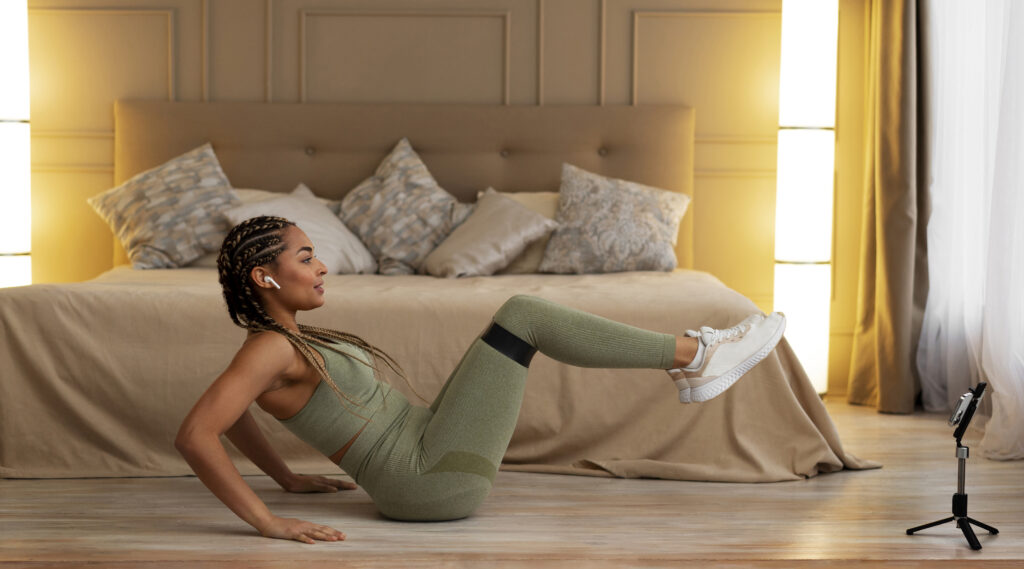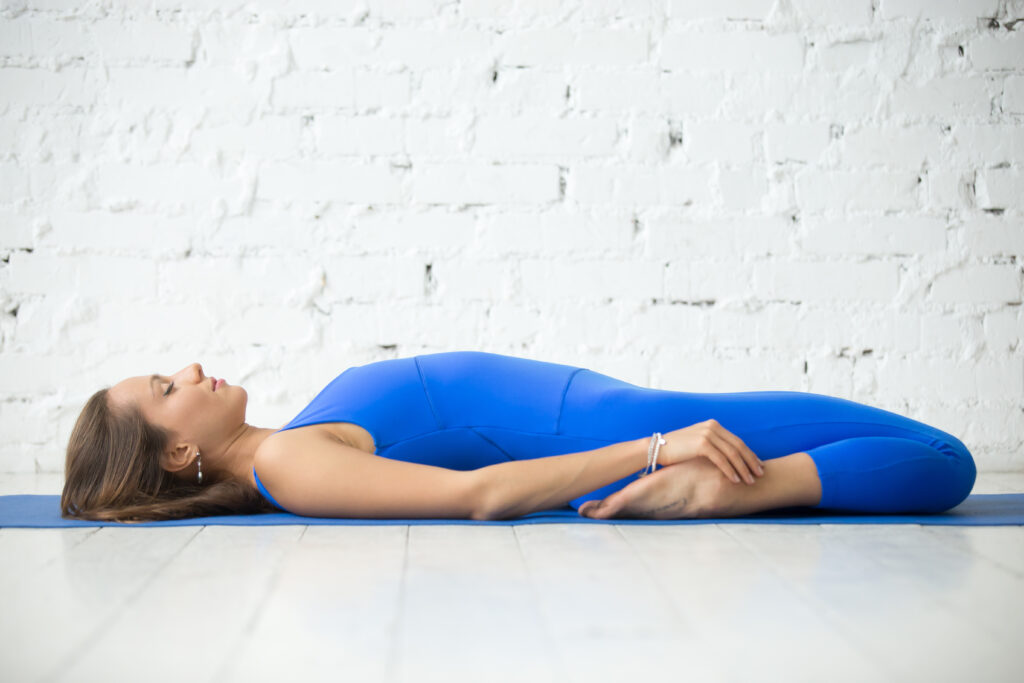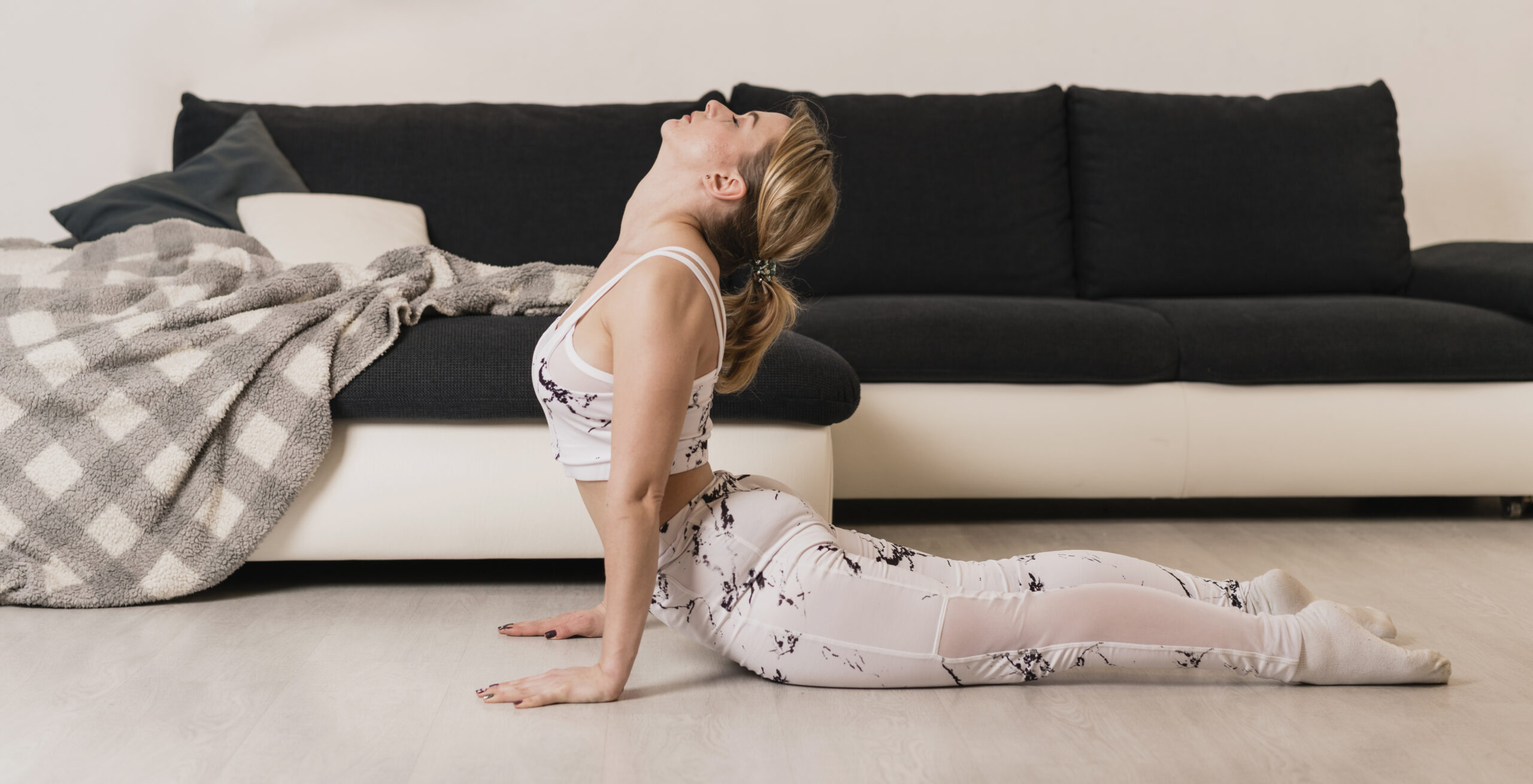Here we are going to share information on the topic “11 yoga poses for better sleep.” Shut your eyes and bid a restful night’s sleep, “Om.” The health of your entire body, from head to toe, depends on how well you sleep. The body uses the nighttime hours to repair, regenerate, revitalize, and slumber, after all.
But a lot of us struggle to go to sleep, stay asleep, or even just get enough sleep. Whether you’re an early riser or a night owl, you could find that you sleep better if you have a regular bedtime practice that includes rolling out a yoga mat. Your body and mind—yes, even your hair—will appreciate you for getting a good night’s sleep and waking up feeling supple, flexible, at ease, and serene.

11 yoga poses for better sleep
The Sleep Science
A healthy sleep schedule is essential to maintaining your body’s optimal functioning. Inadequate sleep can lead to mood swings, diminished immunity, difficulty concentrating, and impaired memory. Sleep is essential for the body and brain to heal, rejuvenate, and regenerate. Thus, incorporating a yoga practice into your nightly routine can be an effective way to support this process.
Yoga is effective for improving sleep by:
- Promoting improved immunological performance
- Increasing adaptability and movement
- Encouraging relaxation by reducing tension in the body and mind
- Easing tense muscles
- Improving and making clear, attentive, and concentrated breathing exercises
The sympathetic nervous system, which is also responsible for the body’s natural “fight or flight” reaction to outside stimuli, is triggered during the REM sleep stage, during which the eyes dart back and forth behind the eyelids. At this point, your blood pressure, respiration, body temperature, and pulse all return to normal for the day. In severe cases, stress can even cause telogen effluvium, or hair loss.
It is believed that the REM phase aids in the brain’s ability to purge unnecessary material from its memory. Those who don’t get enough REM sleep forfeit this benefit. Similar to this, doing yoga for sleep before bed is an additional method of decluttering that can help you release stress from your body and improve mental clarity.
Stress and Sleep: An Intricate Cycle
Stress and sleep—or lack thereof—often go hand in hand. Additionally, stress can cause a host of other health problems, including stress-induced hair loss, and can have a disastrous effect on both your body and mind. Thankfully, yoga not only aids in reducing stress but also has the potential to promote hair growth. A yoga practice before bed can help calm the mind, reduce anxiety, and create the peaceful, relaxed condition required to fall asleep.
Ayurvedic teachings state that the Pitta dosha governs the hours between 10 p.m. and 2 a.m. The body’s primary systems are all rebalanced and rejuvenated by the Pitta dosha. Pitta dosha facilitates the body’s digestion of all substances, including food, knowledge, and emotions. Therefore, sleep deprivation during this limited four-hour period robs the body of this critical healing window.
Your body’s reaction to the outside environment is greatly influenced by the quality of your sleep.
Additional advantages consist of:
- Reduced despondency
- Decreased fear
- Reduce blood pressure and heart rate
- Heightened resilience to stress
- A rise in optimism
- Enhanced Memory
- Enhanced metabolism
Yoga and Breathwork for Nervous System Balance
Breath work patterns that match yoga poses are essential for controlling the central nervous system. The parasympathetic neural system, which controls the body’s basic activities and keeps them functioning normally, is sometimes referred to as the “rest or digest state,” whereas the sympathetic nervous system is sometimes defined as “fight or flight.”
Your breathing pattern gives insight into your energetic state right now: Breathing shallowly and laboriously, like during a strenuous exercise, is a sign of an active and heated sympathetic nervous system (your fight-flight-freeze response). On the other hand, deep, slow breathing, like that found in corpse pose or during meditation, activates the parasympathetic nervous system. You will enter the calming “relax and digest” state more easily as a result.
Try this technique for conscious breathing:
- Take a minute to assess your own needs.
- Take a seat in silence and notice, without passing judgement, the sensations of each breath in and out. Which bodily feelings are you feeling?
- Then take a deep breath in and out, letting your body fully replace the carbon dioxide that is leaving your body with oxygen that is flowing in.
- By doing this, you may bring your attention back to the here and now and reap the complete advantages of breathwork.
By combining particular yoga poses with focused breathing, you can lessen the activation of your sympathetic nervous system, which regulates your body’s reaction to perceived threats. Your parasympathetic nervous system can be activated by taking deep breaths in for five seconds, holding them for two seconds, and then releasing them for five seconds. This can help lower any general stress or worry you may be feeling.
Breathing awareness helps calm agitated bodies and minds. This facilitates a quicker recovery from the sharp oscillations that neurological systems undergo, which in turn leads to a more tranquil state of being. These asana exercises are also essential for immune system health and good respiratory function. Here are some additional suggestions for incorporating wellness into every aspect of your life.
11 Pose Ideas for a Restful Night
For a restorative and therapeutic practice, try the following yoga positions to help your body reset and readjust itself so you can sleep better at night. Cooling inversions, like leaning your legs against the wall, relax and settle the nervous system, which helps with sleeplessness. Furthermore, while the organs of elimination undergo a nightly cleansing, reclining twists provide support for them.
In addition, think about including supplements like GRO+ Advanced Gummies with CBD, which can aid in relaxation and improve sleep quality, or GRO Hair Serum, which might support the health of thinning hair. Namaste to a peaceful, restful night’s sleep and sweet dreams!
11 yoga poses for better sleep
1. The child’s pose, or balasana
Child’s Pose: A Yoga Sleep Position
- Knees bowed, shins pressed against your mat, begin on the ground.
- Put your torso forward. If you’d like, you can place a pillow beneath your forehead.
- You can reach your arms in front of your ears. Alternately, place them beside the body with the palms pointing either downward for greater grounding or upward for greater receptivity.
2. The Uttanasana (Standing Forward Bend)
Yoga Pose: Standing Forward Fold Uttanasana
- Start by keeping your legs as close together as you can while standing with your feet parallel.
- As though you were touching your shins to your forehead, bend forward, hinged from your hip flexors.
- Press the sit bones upward and press the heels down to fully extend the legs. If your knees feel overextended, keep them slightly bent.
- Make an effort to contact your shins with your forehead.
- In the ragdoll version, gently rock the torso back and forth from the hips while holding onto the opposing elbows with your hands.
3. Virasana Supta (Reclining Hero Pose)
Virasana Supta (Reclining Hero Yoga Pose)
- Sit on your shins to begin. At the base of your tailbone, position a pillow or bolster.
- Settle in between the separated ankles by rolling the calves outward with your hands.
- If needed, spread your knees the same width as your hips.
- Reposition yourself on your bolster and support your head and neck with a blanket or cushion.
4. Supta Konasana Baddha (Reclining Bound Angle Pose)
Baddha Konasana Supta (Reclining Bound Angle Yoga Pose)
- Starting from a seated position, place a cushion or bolster beneath the sacrum.
- With your knees bent and your feet flat on the floor, adopt a butterfly stance.
- With your spine resting on the pillow or bolster, lie back at an angle. Place another cushion or a rolled-up blanket under your head to elevate it above your heart.
- Open your knees as wide as you can and settle into the props completely.
5. The Malasana (Garland Pose)
Garland Yoga Pose in Malasana
- Legs hip-distance apart, start from a standing position. With the body down into a squat and the toes pointed toward the mat’s outside edges, bend your knees.
- Fold forward from the hips, putting your hands between your knees on the mat or on blocks.
- Tuck your chin gently in toward your chest, stretching your cervical spine, and letting your head’s crown fall naturally toward the mat. If your head is not in contact with the mat, you can also place a block or cushion underneath it.
6. Sana Paschimottana (Seated Forward Fold)
Forward-Leaning Pose: Yoga for Sleep
- Place a block in front of your feet and sit with your legs straight out in front of you.
- Put your arms out in front of your ears.
- Lean forward, relying on your hips. For a more profound shoulder stretch, reach for your feet, ankles, or the block.
7. Matsyendrasana Supta (Supine Spinal Twist)
Spinal Twist in Supine
- While lying on your back, raise your knees to your chest.
- Gently press the backs of the shoulder blades and the arms into the mat while encircling the ears like a cactus.
- Lower your bowed knees to one side; if you’d like, turn your head and neck to face the other shoulder.
- After holding your breath for a few rounds, switch sides.
8. Legs Up the Wall (Viparita Karani)
- As you lay on your side, try to position your glutes and tailbone as close to the wall as you can.
- Turn over to lie on your back and extend your legs straight up, supporting your rear end against the wall.
- To establish a more profound sense of groundedness, you can throw a rolled-up blanket on top of the feet or place a block or cushion on the low abdomen.
9. Rajakapotasana Utthita Eka Pada (Half-Leg Pigeon Pose)
Half-Lion Pose in Yoga
- Start in a downward dog or on your hands and knees. Bend and bring one knee forward, putting your shin at a diagonal angle on the ground. To help you release further into the stretch, you can add additional support by placing a block or pillow underneath your hip.
- To increase the depth of the hamstring stretch, extend through your longer rear leg.
- Move your hands forward gently. To rest forearms on the mat, bend elbows downward.
- To repeat on the other hip, switch sides.
10. Pristhasana Utthan (Lizard Pose)
Pristhasana Utthan (Lizard Pose)
- Begin on all fours and place your thumbs together in the middle of the mat.
- Step one foot forward so that it is squarely outside the matching wrist and hand.
- To initiate the hip flexor stretch, extend your body forward.
- The hamstrings will then lengthen and stretch as you push your body back.
- On the other foot, repeat.
11. The Corpse Pose (Savasana)
- Put yourself on your back. If preferred, place a small pillow or rolled-up blanket to support the head and neck.
- Let your arms hang loosely by your sides, with your palms facing upwards.
- Toes pointed outward and heels facing each other, legs spread as wide as comfortable.
- Soften your jaw and cheeks when you close your eyes by deliberately relaxing the muscles in your face, starting at the temples and working your way down.
- Look inward to see if you are clenching or holding onto any muscle tension; then, relax and let go.
- Let your breathing come in its own time and rhythm.
Frequently Asked Questions
11 yoga poses for better sleep
What is the sleeping asana pose?
Answer: Savasana (Corpse Pose) Lay flat on your back with your arms at your sides, palms facing up, and your legs relaxed at least hip-distance apart. If you’d like, throw a folded blanket under your head for relaxation and arrange a bolster or two pillows under your knees to release stress in your low back.
Does yoga promote deeper slumber?
Answer: Yoga activities entail stretching and relaxing muscles, which can cause significant physical and mental exertion and lead to higher sleep efficiency, fewer sleep disruptions, less latency, and more deep sleep. This could be one explanation for why yoga practitioners have better sleep quality.
Does yoga help with sleepiness?
Answer: Yoga and sleep
Our ability to sleep is unaffected by yoga. Yoga promotes mental and physical relaxation, and when we are mentally and physically at ease, we are more likely to sleep soundly.
How to sleep better and fall asleep more quickly
Answer: Maintain a healthy sleep schedule (sleep hygiene). To aid in falling asleep, try meditation. Unwind and relax.
- For better sleep, try practicing mindfulness.
- Establish a comfortable sleeping space.
- Don’t push yourself to sleep.
- Boost your sleep quality with food and exercise.
What is sleep, Mudra?
Answer: The mudra of life energy, or prana mudra: The body and brain are known to be impacted by prana mudra. You can start the body’s removal processes by touching the tips of the ring, thumb, and little finger together while maintaining the other fingers straight. This can help relieve tension before going to bed.
Which forms of yoga shorten sleep duration?
Answer: By doing kapalbhati, anulom vilom, and bhastrika pranayam while seated in padmasana or vajrasana, you can achieve a balance between wakefulness and sleep. facilitates blood circulation and simple digestion. Sleep is impacted by healthy digestion and blood circulation.

Conclusion
11 yoga poses for better sleep
Finally, adding yoga to your nighttime regimen can greatly enhance the quality of your sleep. The 11 yoga poses listed here provide a simple and efficient means of unwinding the body and settling the mind in preparation for sleep. Regular practice of these postures can lead to a deeper sensation of relaxation, more flexibility, and a reduction in stress levels, all of which improve sleep patterns and general well-being. Adopting these straightforward but effective methods can improve general physical and mental health and promote a more restful night’s sleep.
So, this is how the topic “11 yoga poses for better sleep” has been addressed.
For more information related to these topics,
You may also visit our Instagram page by
Thank you!

